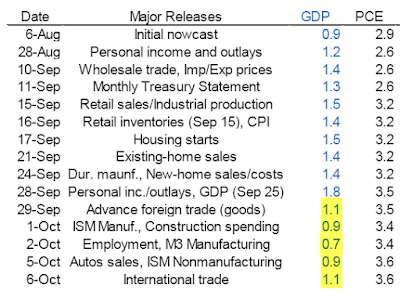Mish's Global Economic Trend Analysis |
- Central Bank Balance Sheets: What Will They Look Like in 2016-2017?
- Economists Chase Tails and Tales, Cut GDP Estimates Again
- Trade Deficit Widens to $48.3 Billion, Up From $41.8 Billion; iPhone Connection
| Central Bank Balance Sheets: What Will They Look Like in 2016-2017? Posted: 06 Oct 2015 07:07 PM PDT Reader Gary emailed a link to JP Morgan's Quarterly Market Guide. Here are a pair of charts from page 19 that caught my eye. Central Bank Policy Rates  Current Rates
Central Bank Balance Sheets  Three Questions
Mike "Mish" Shedlock |
| Economists Chase Tails and Tales, Cut GDP Estimates Again Posted: 06 Oct 2015 11:43 AM PDT Tail Chase In the wake of recent economic data, economists at the IMF and Deutsche Bank lowered their growth estimates. IMF Cuts Forecast Again Like a dog running in futile circles hoping to catch its tail, the IMF does the same thing with its perennially over-optimistic assessment of everything from emerging markets to the G7 economies. Reuters reports the IMF cuts global growth forecasts again, citing commodity and China worries. The International Monetary Fund cut its global growth forecasts for a second time this year on Tuesday, citing weak commodity prices and a slowdown in China and warned that policies aimed at increasing demand were needed.Deutsche's "Weatherman" Cuts Growth Outlook Citing today's trade deficit report (see Trade Deficit Widens to $48.3 Billion, Up From $41.8 Billion; iPhone Connection), Deutsche Bank's chief US economist Joseph LaVorgna joins the IMF in a tail-chasing exercise. ZeroHedge reports LaVorgna Throws In The Towel On US Economy As Deutsche's "Weatherman" Cuts Growth Outlook. One of the biggest permabulls on the Street is apparently turning bearish as Deutsche Bank's chief US economist Joseph LaVorgna throws in the towel after taking a look at August trade date.LaVorgna's Tail-Chasing Exercise Until today, LaVorgna had been predicting 3% third quarter GDP growth, a fairy tale number never approached in the Atlanta Fed GDPNow Model. Today, the Atlanta Fed model forecast actually rose, having taken into account the advance trade numbers on September 29.  Note that the Atlanta Fed model was never above 1.8% whereas LaVorgna was at the top end of the most recent "Blue Chip" consensus. More than likely, LaVorgna's tail-chasing exercise is not over. Evolution of GDP Forecast  On September 29, the GDPNow model declined from 1.8% to 1.1% with the advance foreign trade numbers. Following auto sales and today's more complete trade numbers, the model forecast is back to 1.1%. The GDPNow forecast fell as low as 0.7% on October 2, following the dismal jobs report. (Please see Payroll Disaster: Establishment Survey +142K Jobs, Employment -236K; Labor Force -350K; 59K Downward Revisions). Tale Chase Economists not only chase "tails", they also chase "tales" with each "tale" a bit less optimistic than the preceding one, yet still too optimistic. Mike "Mish" Shedlock |
| Trade Deficit Widens to $48.3 Billion, Up From $41.8 Billion; iPhone Connection Posted: 06 Oct 2015 09:53 AM PDT Today the US Commerce department report on International Trade in Goods and Services shows the trade deficit rose by $6.6 billion to $48.3 billion. The numbers are for August, very backwards-looking given it is now October. August exports were $185.1 billion, $3.7 billion less than July exports. August imports were $233.4 billion, $2.8 billion more than July imports. Balance of Trade Since August 2013  Balance of Trade Moving Average  iPhone Connection The increased deficit was widely expected, in line with the Bloomberg Economic Consensus of -48.6 billion. A surge in imports of new iPhones helped feed what was an unusually wide trade gap in August of $48.3 billion, well up from July's revised $41.8 billion. But cell phones, at $2.1 billion, make up only a portion of the gap with a drop in exports the most salient factor. Exports were down nearly across the board including industrial supplies at minus $2.2 billion, consumer goods at minus $0.6 million, autos at minus $0.5 million, and foods/feeds/beverages at minus $0.3 million. Weakness in exports reflects weakness in foreign demand together with the strength of the dollar.Actually, this was pretty much factored into third quarter GDP estimates when the "advance numbers" came out last week. And these numbers, already way late, frequently sport huge revisions. Once again, GDP is a very lagging number. Mike "Mish" Shedlock |
| You are subscribed to email updates from Mish's Global Economic Trend Analysis. To stop receiving these emails, you may unsubscribe now. | Email delivery powered by Google |
| Google Inc., 1600 Amphitheatre Parkway, Mountain View, CA 94043, United States | |
No comments:
Post a Comment